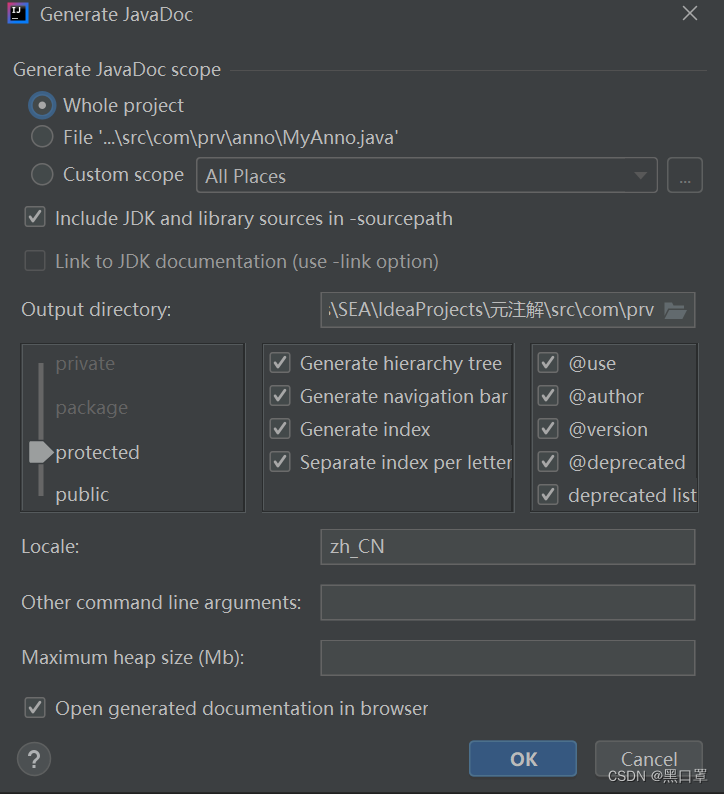Tabla de contenido
El significado de las metaanotaciones
@Retención @Objetivo @Documentado @Heredado @Repetible
El significado de las metaanotaciones
Se utiliza para describir la ubicación, el alcance, la herencia y la extracción de documentos de las anotaciones.
@Retención
import java.lang.annotation.Retention;
import java.lang.annotation.RetentionPolicy;
// @Retention(RetentionPolicy.SOURCE) // MyAnno注解在源代码中有效
// @Retention(RetentionPolicy.CLASS) // MyAnno注解在类文件中有效
@Retention(RetentionPolicy.RUNTIME) // MyAnno注解在运行时有效
public @interface MyAnno {
public String value() default "";
}@MyAnno("我是一个注解")
public class AnnoTest {
public static void main(String[] args) {
AnnoTest at= new AnnoTest();
MyAnno annotate = at.getClass().getAnnotation(MyAnno.class);
System.out.println(annotate.value());
}
}
输出:我是一个注解@Objetivo
Indica en qué elementos se puede utilizar esta anotación.

ElementType.ANNOTATION_TYPE: Anotación
ElementType.CONSTRUCTOR: Constructor
ElementType.FIELD: campos, constantes de enumeración
ElementType.LOCAL_VARIABLE: variable local
ElementType.METHOD: Método
ElementType.PACKAGE: 包
ElementType.PARAMETER: parámetro formal
ElementType.TYPE: Clase, interfaz, anotación, enumeración
ElementType.TYPE_PARAMETER: parámetro de tipo
ElementType.TYPE_USE: Uso de tipo
@Target({ElementType.METHOD,ElementType.FIELD})
public @interface MyAnno {
public String value() default "";
}@Documentado
La información de anotaciones se puede extraer en la documentación de la API mediante la herramienta javadoc.
@Documented
public @interface MyAnno {
public String value() default "";
}Ruta IDE: Herramientas - Generar JavaDoc


@Heredado
Las anotaciones modificadas se heredan.
import java.lang.annotation.ElementType;
import java.lang.annotation.Inherited;
import java.lang.annotation.Retention;
import java.lang.annotation.RetentionPolicy;
import java.lang.annotation.Target;
@Inherited
@Target(ElementType.TYPE)
@Retention(RetentionPolicy.RUNTIME)
public @interface MyAnnotation {
public String value() default "";
}@MyAnnotation("父亲")
public class Father {}public class Child extends Father{
public static void main(String[] args) {
Class<Child> child=Child.class;
MyAnnotation anno = child.getAnnotation(MyAnnotation.class);
System.out.println(anno.value());
}
}
输出:父亲@Repetible
La anotación declarada se puede anotar repetidamente en el elemento correspondiente, y esta anotación repetible se puede incluir mediante el valor de otra anotación.
import java.lang.annotation.*;
@Retention(RetentionPolicy.RUNTIME) //
@Target(ElementType.TYPE)
public @interface MyAnnos {
MyAnno[] value() ;
}@Retention(RetentionPolicy.RUNTIME)
@Target(ElementType.TYPE)
@Repeatable(MyAnnos.class)
public @interface MyAnno {
String value() default "";
}import com.prv.anno.MyAnno;
@MyAnno("anno")
@MyAnno("lala")
public class AnnoTest {
public static void main(String[] args) {
MyAnno[] fileTypes = new AnnoTest().getClass().getAnnotationsByType(MyAnno.class);
for (MyAnno myAnno : fileTypes) {
System.out.println(myAnno.value());
}
}
}
输出:
anno
lala